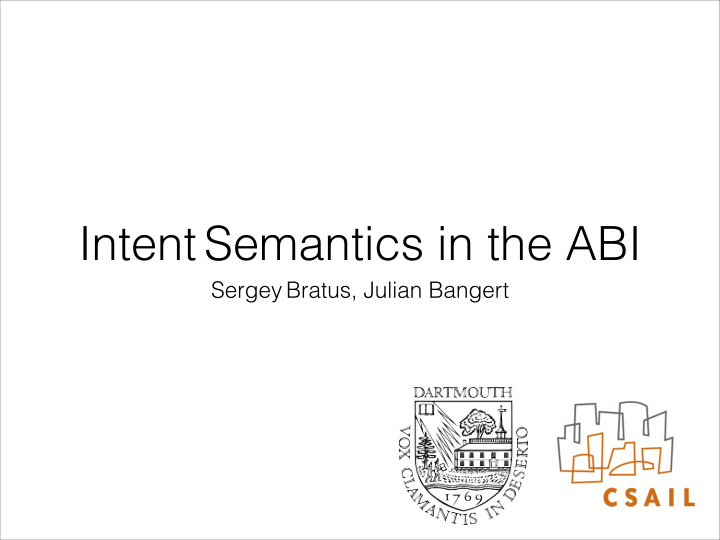



Intent Semantics in the ABI Sergey Bratus, Julian Bangert
Outline • From faulty classic policies to a new sweet spot • ABI-level objects and security policy • ABI-level policy examples • Why this works on x86 • Future directions
Traditional Security • Traditional security models assume: • One process does one thing • Static bag of permissions for the entire process • Usable at any point, in any order, any number of times
If JS is your OS, what is your reference monitor? • Is your data in objects you can label ? • Does it even touch any filesystem? Valuable Objects • If it is, can you trap on access to it? • Does it ever go through a syscall or ? VM lookup? Virtual memory • For DOM: Is Same Origin even the right MMU labelling scheme?
A process is a process is a process • For a " task ", the "bag of permissions" model is adequate. For a " process ", it isn't • A "process" goes through changes over time • Yet in policy we treat it as just a "task", monolithic • This is wrong and counter-intuitive • What are the " units " or " phases " of a process?
http://www.tomdalling.com/blog/software-design/solid-class-design-the-liskov-substitution-principle/
Process phases • "Phase" ~ code unit ~ EIP range ~ memory section
"Some thoughts on security after ten years of qmail", D.J. Bernstein, 2007 • Used process isolation as security boundaries • Split functionality into many per-process pieces • Enforced explicit data flow via process isolation • Avoided in-process parsing • Least privilege was a distraction, but isolation worked http://cr.yp.to/qmail/qmailsec-20071101.pdf
Traditional Security vs. Modern Software • Software is complicated, integrates many functions • "The *** Shopping App Now Backs Up Your Photos" • High engineering costs to manually isolate components /functional units a-la qmail • Semantic subdivision occurs at ABI section level • Code & data sections reflect different intent � • Functional units ~ ABI semantic units
Policy Granularity: ABI is the Sweet Spot ABI
Intent-level semantics • " The gostak distims the doshes " -- Andrew Ingraham, 1903 • Non-dictionary words, English grammar • Semantics == relationships between terms • Relationships between code & data sections reflect their intent , often uniquely
Access relationships are key to programmer intent • Unit semantics ~ Explicit data flows (cf. qmail )
Separation of concerns in OS engineering practice • Sections describe the intent of code and data • Example: Dynamic linker/loader operates on • GOT in ELF, function stubs in PLT • IAT , import & export data tables in PE
Enforcing • Modern OS loaders discard section information • New architecture: • ' Unforgetful loader' preserves section identity after loading • Enforcement scheme for intent-level semantics • Better tools to capture semantics in ABI
Motivating Example
Example policies • Web application decompresses a PNG file • Mental model libpng .PNG file Bitmap
What attackers see no-longer-private private key key .PNG file malicious .PNG Bitmap with leaked libpng data w/ bugs
Or Bitmap overwrites Authorized keys critical data .PNG file, with malicious .PNG exploit libpng w/ bugs
Mapping it into the ABI • Easy to introduce new sections • Each code segment can get different permissions libssl .data private key • Only libssl.text can access libssl.data libpng .input malicious .PNG • libpng.text can only access libpng.input and libpng.output libpng .output bitmap • And libpng.input can only be read by libpng.
Back to our example SSL initialization SSL libpng app logic RW R R RW W RW SSL keys Input buffer Output buffer
The Implementation http://upload.wikimedia.org/wikipedia/commons/a/a6/Professor_Lucifer_Butts.gif
Implementation on X86 • Prototype on Linux with X86 virtual memory • Each state of execution sees a different subset of the address space � • Traps handle state transitions by changing CR3 � • Each state has its own page tables that cache part of the address space, reusing existing TLB invalidation primitives. • Use PCID on newer processors to reduce TLB misses
Prototype: Cloud to the rescue! • Performance hit still rather bad: 30% on simple NGINX benchmark isolating all libraries • Too many state transitions on the hot path • Policy must be adapted to application structure • Less overhead (~15%) when running on KVM • KVM already incurs performance costs, so we don't have to suffer them • KVM also optimizes virtual memory handling
Binary Rewriting Tools • Policy injection through metadata rewriting: • Mithril , currently only implemented for ELF • Translates binaries into a canonical form that is less context-dependent and can be easily modified • Tested on the entire Debian x86_64 archive, producing a bootable system • ~25GB of packages
Future directions • Working on enforcing ELFBac-style policies with CFI • Implementation to ARM (because phones rule!): • Domain Control Register: 16 sub-spaces that can be disabled/enabled without flushing caches • Can handle a sub-lattice of an ELFbac policy to reduce supervisor entries. • Would have to run all user space under virtualization, in kernel mode
Takeaway • Per-process bags of permission are no longer a suitable basis for policy • Instead, ABI-level memory objects at process runtime are the sweet spot for security policy • Modern ABIs provide enough granularity to capture programmers intent w.r.t. code and data units • Intent-level semantics compatible with ABI, standard build/binary tool chains
Recommend
More recommend